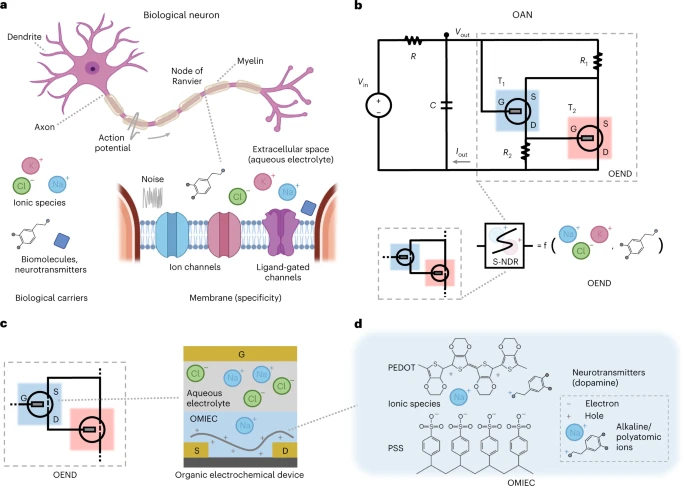Scientists have developed the first biorealistic artificial neuron that can effectively affect true biological neurons.

The development of artificial intelligence has been going on for a long time, but today remains a hot topic. The computer algorithm “learns” based on examples and determines its correct and incorrect answers. Unlike a computer algorithm, the human brain works with neurons – brain cells. They learn and transmit signals to other neurons. This complex network of neurons, paths and synapses controls our thoughts and actions.
Biological signals are much more diverse than ordinary computer signals. Neurons in the biological neural network interact with the biochemical environment. In particular, neurons “communicate” or chemically, releasing relay substances or using electrical impulses.
The effective effect of artificial neurons is the key to the development of neuromorphic electronics. Artificial neurons must realistically simulate the function of their biological counterparts and process the full range of signals existing in biology.
At the moment, the biggest problem is the inability of such neurons to work in a biological environment, which significantly reduces their capabilities. Based on conventional circuit generators, many varieties of artificial organic neurons have been created. They electrically imitate their biological counterparts, but do not include a moist biological environment, which consists of ions, biomolecules and neurotransmitters.
Scientists led by Paschalis Gkooupidenis, head of the group in the Paul Boma department at the Max Polck polymer research Institute, solved this problem and developed the first biorealistic artificial neuron based on a compact non -linear electrochemical element. Artificial neuron can work in a liquid and is sensitive to the concentration of biological substances (such as dopamine or ions) in its environment. It can generate different dynamics of impulses that exists in biology. As a result, such artificial neurons will be able to “communicate” with their true biological counterparts.
According to GkoPidenis, such an artificial element can become the key to biorealistic neuroprosthesis, which will communicate in the same language as biology, enabling effective restoration, replacement or even increasing the function of the nervous system.
Organic artificial neuron (OAN) is made of a compact non -linear element consisting of only two organic electrochemical transistors (OECT). They operate in the aquatic environment and are sensitive to ion molecules and multifaceted ions. OAN has key features observed in the peak response of biological neurons. Oan works in liquid, and this property resembles the extracellular environment of biological neurons in the cerebrospinal fluid. Oan, i.e. neuron tendency to sharpen spikes, can be modulated by the presence of electrochemical oscillations transmitted through the flow of ions in the electrolytic environment. The electrochemical oscillations of the liquid create Oan activation properties, imitating the characteristic features of biological neurons. As already mentioned, Oan is designed on the basis of a non -linear electrochemical element. Like biological neurons that operate in a humid environment, Oan can imitate biological sensitivity to ion and biomolecular particles in the surrounding aquatic environment. Artificial neuron shows non -linear phenomena that depend on the composition of the biophysically important host environment. Scientists have experimentally confirmed by various electrolytes, including typical hydroceleous electrolytes, buffer solutions and cellular breeding medium. They also created biohybrid interfaces in which Oan was modulated by the biological membrane of epithelial cells in real time.
As a result, scientists managed to create an artificial neuron that behaves realistically and is able to communicate in biological environments in various ways, including chemically or through ion cargo carriers.
Read the published research article Here.


















